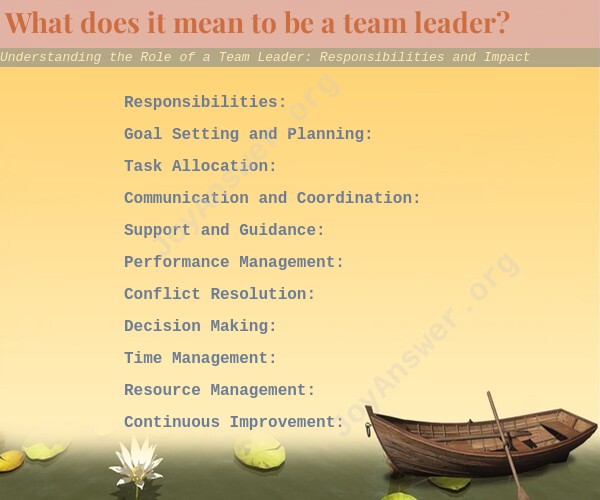What does it mean to be a team leader?
The role of a team leader is crucial within an organization, as they play a pivotal role in guiding, managing, and empowering their team members to achieve shared goals. Here's a comprehensive overview of the responsibilities and impact of a team leader:
Responsibilities:
Goal Setting and Planning:Team leaders collaborate with higher management to define team objectives, goals, and strategies. They break down larger goals into actionable tasks and create plans to achieve them.
Task Allocation:Team leaders assign tasks and responsibilities to team members based on their skills, strengths, and workload. They ensure a fair distribution of tasks to optimize efficiency and productivity.
Communication and Coordination:Effective communication is key. Team leaders facilitate open communication within the team, ensuring everyone is aligned and informed about project updates, changes, and expectations.
Support and Guidance:Team leaders provide guidance, mentorship, and support to team members. They help resolve challenges, offer solutions, and assist in professional development.
Performance Management:Team leaders monitor individual and collective performance. They provide regular feedback, conduct performance evaluations, and identify opportunities for improvement.
Conflict Resolution:Inevitable conflicts may arise within a team. Team leaders are responsible for addressing conflicts, mediating disagreements, and fostering a positive work environment.
Decision Making:Team leaders make informed decisions that benefit the team's objectives and align with organizational goals. They balance team input and consider various perspectives.
Time Management:Prioritization and time management are critical. Team leaders ensure tasks are completed within deadlines and that the team's time is used effectively.
Resource Management:Team leaders manage resources, including budget, equipment, and tools, to ensure the team has what it needs to succeed.
Continuous Improvement:Team leaders promote a culture of continuous improvement. They identify areas for growth, suggest process enhancements, and implement best practices.
Impact:
Employee Engagement:Effective team leaders create a positive and engaging work environment. They inspire team members to give their best, fostering job satisfaction and reducing turnover.
Performance Enhancement:A skilled team leader motivates and empowers their team to excel. Improved performance leads to higher productivity, increased quality, and successful project outcomes.
Collaboration and Synergy:Team leaders encourage collaboration among team members. Their guidance promotes synergy, where the collective effort produces better results than individual contributions.
Personal and Professional Growth:Team leaders support the growth and development of their team members. By providing opportunities for learning and advancement, they contribute to employees' career progression.
Positive Culture:Team leaders influence the team's culture by setting the tone for respect, trust, and cooperation. A positive culture contributes to overall job satisfaction and organizational success.
Effective Problem Solving:When challenges arise, a strong team leader's decision-making skills help the team navigate obstacles and find creative solutions.
Organizational Alignment:Team leaders ensure that their team's efforts are aligned with the organization's mission, vision, and goals, contributing to the overall success of the company.
In essence, a skilled team leader is a driving force behind a successful team. Their responsibilities and impact extend beyond task management, influencing team dynamics, morale, and the organization's overall performance.


